The National Register of Historic Places (NRHP) is the United States federal government's official list of districts, sites, buildings, structures and objects deemed worthy of preservation for their historical significance. A property listed in the National Register, or located within a National Register Historic District, may qualify for tax incentives derived from the total value of expenses incurred in preserving the property.
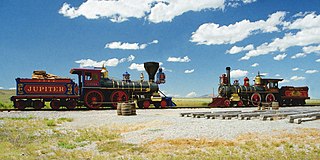
Golden Spike National Historical Park is a United States National Historical Park located at Promontory Summit, north of the Great Salt Lake in east-central Box Elder County, Utah, United States. The nearest city is Corinne, approximately 23 miles (37 km) east-southeast of the site.
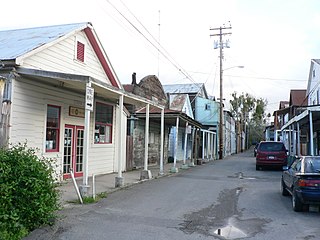
Locke, also known as Locke Historic District, is an unincorporated community in California's Sacramento–San Joaquin River Delta. The 10 acre town was built between 1893 and 1915 approximately one mile north of the town of Walnut Grove. Prior to the railroads and town, the delta swampland was home to Native American Miwoc and Maidu tribes for hundreds of years. Tribal burial grounds exist on the Locke parcel. The village of Lockeport began where the Sacramento Valley Railway and Union Pacific Railroads merged at the southwest corner of the 490 acre swampland parcel deeded on July 6, 1883 to Founder, George W. Locke and his mercantile business partner, Samuel P. Lavenson. Both men were lured in their youth by the California Gold Rush from their birthplaces in New Hampshire.

Expo '74, officially known as the International Exposition on the Environment, Spokane 1974, was a world's fair held May 4, 1974, to November 3, 1974 in Spokane, Washington in the northwest United States. It was the first environmentally themed world's fair and attended by roughly 5.6 million people. The heart of the fair park grounds was located on Canada Island, Havermale Island, and the adjacent south bank of the Spokane River, comprising present-day Riverfront Park, in the center of the city.
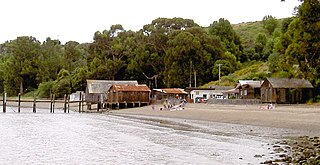
China Camp State Park is a state park in Marin County, California, surrounding a historic Chinese American shrimp-fishing village and a salt marsh. The park is located in San Rafael, California, on the shore of San Pablo Bay. It is known for its hiking and mountain biking trails, scenic views, and open spaces. The 1,514-acre (613 ha) park was established in 1976. A 75-acre (30 ha) district, including the shrimping village and a prehistoric shell midden, were added to the National Register of Historic Places in 1979 for having state-level significance in archaeology, architecture, commerce, settlement, and social history. China Camp State Park, along with the Rush Ranch Open Space Preserve, is part of the San Francisco Bay National Estuarine Research Reserve.

This is a list of properties and historic districts in Washington that are listed on the National Register of Historic Places. There are at least three listings in each of Washington's 39 counties.

Ward Charcoal Ovens State Historic Park is an area designated for historic preservation and public recreation located 20 miles (32 km) south of the town of Ely in White Pine County, Nevada. The 700-acre (280 ha) state park protects beehive-shaped charcoal ovens constructed in the latter half of the 19th century.

Hells Canyon National Recreation Area is a United States national recreation area on the borders of the U.S. states of Oregon and Idaho. Managed by the U.S. Forest Service as part of the Wallowa-Whitman National Forest, the recreation area was established by Congress and signed by President Gerald Ford in late 1975 to protect the historic and archaeological values of the Hells Canyon area and the area of the Snake River between Hells Canyon Dam and the Oregon–Washington border.
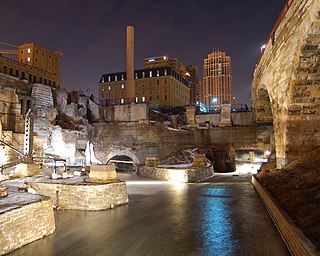
Mill Ruins Park is a park in downtown Minneapolis, Minnesota, United States, standing on the west side of Saint Anthony Falls on the Mississippi River. The park interprets the history of flour milling in Minneapolis and shows the ruins of several flour mills that were abandoned.

The Village of East Davenport, also known simply as The Village, is located along the Mississippi River on the southeast side of Davenport, Iowa, United States. It was listed as a historic district on the National Register of Historic Places in 1980 as the Davenport Village. At the time of its nomination it included 145 contributing properties, most of which were working-class housing.

The Telluride Historic District encompasses a significant portion of the developed area of the former mining boom town of Telluride, Colorado. Telluride was founded in 1878, and was a major metals mining center until 1913. The historic district covers 80 acres (32 ha) of downtown Telluride and surrounding residential areas, as well as Lone Tree Cemetery, the town's first cemetery. It was declared a National Historic Landmark in 1961 for its well-preserved late boom-town architecture.

There are 70 properties listed on the National Register of Historic Places in Albany, New York, United States. Six are additionally designated as National Historic Landmarks (NHLs), the most of any city in the state after New York City. Another 14 are historic districts, for which 20 of the listings are also contributing properties. Two properties, both buildings, that had been listed in the past but have since been demolished have been delisted; one building that is also no longer extant remains listed.

The Dunlap coke ovens are the remnants of a coke production facility near Dunlap, in the U.S. state of Tennessee. Built in the early 1900s, the facility consists of five batteries of 268 beehive ovens, which operated under various companies until the early 1920s. The ovens are now listed on the National Register of Historic Places, and are maintained by the Sequatchie Valley Historical Society as part of Dunlap Coke Ovens Park.

The Brierfield Furnace, also known as the Bibb Naval Furnace and Brierfield Ironworks, is a historic district in Brierfield, Alabama. The district covers 486 acres (197 ha) and includes one building and nine sites. It was listed on the National Register of Historic Places on November 20, 1974. The district is encompassed by Brierfield Ironworks Historical State Park.
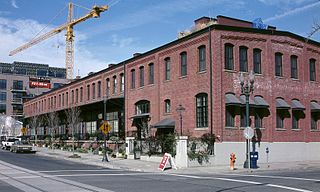
The North Bank Depot Buildings, in central Portland, Oregon, United States, are a pair of buildings formerly used as a freight warehouse and passenger terminal for the Spokane, Portland and Seattle Railway (SP&S). Formed in 1905, the SP&S was commonly known as the North Bank Road during the period in which these buildings were in use. The Portland buildings' passenger facilities were also used by the Oregon Electric Railway after that railway was acquired by the SP&S. Located in what is now known as the Pearl District, the buildings were listed on the National Register of Historic Places in 1996. They were in use by the SP&S and its successor, Burlington Northern Railroad, from 1908 until the 1980s. Only the east building was used as a passenger station, and this usage lasted from 1908 until 1931.

The Camptown Historic District, also known as the La Mott Historic District and Camp William Penn, is a national historic district located in La Mott, Pennsylvania. It is well known for the residence of famous abolitionist and suffragette Lucretia Mott. It was also a stop on the Underground Railroad. It played a crucial role in the Civil War; from 1863 to 1865, it housed Camp William Penn, a military training post for African-American soldiers. Following the war, many of the soldiers bought homes in the area. The area was said to be named "Camptown," but, since there was already another community in Pennsylvania that used that name, the name "La Mott" was chosen when the post office was established in 1885. The district covers 26 acres, and includes 35 contributing buildings.

Jackson–Washington State Forest is a state forest in Jackson and Washington Counties, Indiana, near the town of Brownstown. The forest includes over 18,000 acres (7,300 ha), most of which was bought by the state in the 1930s and 1950s. Jackson–Washington State Forest offers camping, fishing, hunting, archery, and trails for hiking, horseback riding, and cycling.
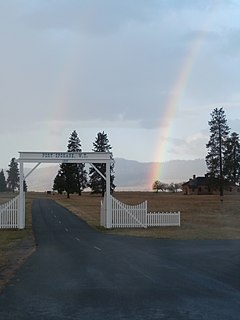
Fort Spokane was a U.S. Army frontier outpost in Lincoln County, Washington. It was located at the confluence of the Columbia and Spokane rivers and was used to separate the Colville and Spokane tribes on their reservations from the newly established city of Spokane. The fort was last used in 1929 and was later incorporated into the Lake Roosevelt National Recreation Area and is listed on the National Register of Historic Places.

The Guffey Butte–Black Butte Archeological District is a 14,000 acres (57 km2) historic district in southwestern Idaho, United States, that is listed on the National Register of Historic Places (NRHP). It includes numerous archeological sites in Ada, Canyon, Elmore, and Owyhee counties.



















